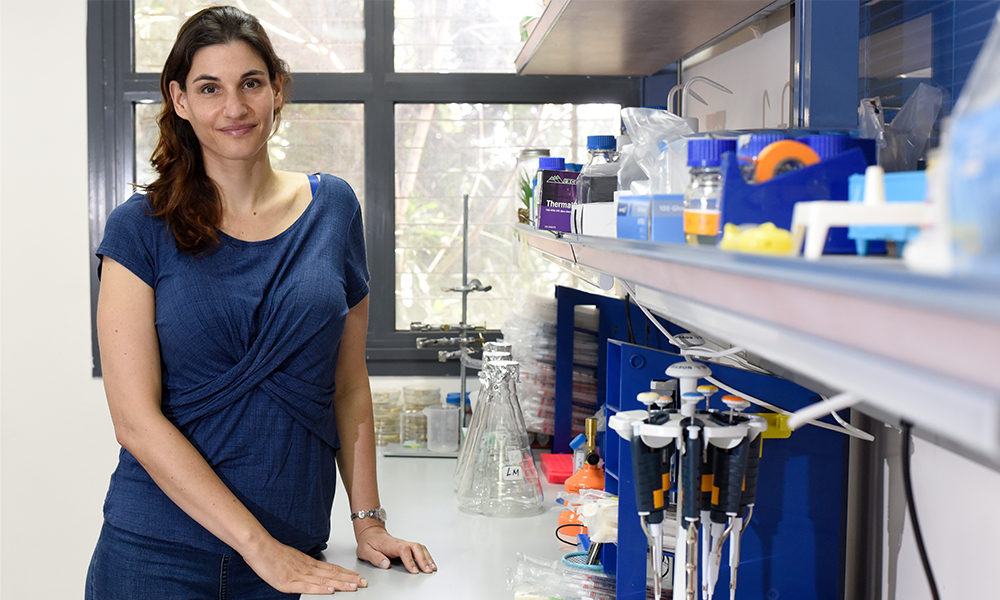
Welcome: Meytal Landau
New associate group leader at EMBL Hamburg investigates the structure of functional amyloids in bacteria and in human disease

Amyloids are protein aggregates known for their role in neurodegenerative diseases like Alzheimer’s or Parkinson’s. They’re also secreted by some bacteria. During a one-year sabbatical at EMBL Hamburg, Israeli structural biologist Meytal Landau made use of the site’s infrastructure to deepen her study of amyloids in bacteria and in human diseases. She has now joined EMBL as an associate group leader.
Tell me about your scientific background. How did you become interested in science?
My interest in science started early on, at the age of six, when I received a medicine to treat a fever. I was curious how medications affect the body. This curiosity was fuelled when I was diagnosed with lymphoma and leukaemia at the age of 15. I spent most of my high-school years in hospital, including undergoing multiple orthopaedic surgeries that resulted from the cancer treatment, and which are still a part of my life today. During that time, I was very much interested in the mechanisms and effects of drugs. This led me to study pharmacology. During my bachelor’s degree I became fascinated with proteins, their three-dimensional structures, dynamics, and mechanisms of action. This led me to a PhD in computational biochemistry and later to postdoctoral studies in structural biology, specialising in X-ray microcrystallography for the study of amyloid fibrils interacting with drugs or for diagnostic purposes.
What was it that attracted you to EMBL as a place to work?
I’d been familiar with EMBL for many years, as it’s known worldwide as a multinational and multidisciplinary organisation striving for excellence. I was especially familiar with the Hamburg site, which operates beamlines at the PETRA III X-ray source at the Deutsches Elektronen-Synchrotron (DESY). The EMBL beamlines are among the few across Europe that are suited for crystallographic studies of amyloid fibrils. I’ve been travelling to EMBL Hamburg with my Israeli group during recent years to conduct research at the EMBL facilities. With the recent involvement of EMBL in the establishment of advanced cryo-electron and light microscopy facilities on the DESY campus, within the Centre for Structural Systems Biology (CSSB), the Hamburg site became very attractive for challenging structural studies performed under one roof. During my sabbatical year, I was exposed to EMBL’s collegial, supportive, and pleasant work environment, which also motivated me to extend my affiliation.
What will your group focus on at EMBL?
My main research interests are within the field of structural biology. We will focus on a unique and newly discovered set of proteins and peptides that self-assemble into ordered fibrils, a process that has been considered for decades to be associated with human diseases. However, several fibrils evolved to carry out specific activities in all kingdoms of life, for example antimicrobials or other toxins. Some fibrils secreted by microbes participate in aggressive and resistant forms of infections, and can serve as targets for novel drugs. Drugs acting against these microbial weapons without killing the microbes might induce less drug resistance. Some microbial fibrils might also act as transmissible agents and affect the likelihood of developing neurodegenerative diseases.
What are some of the challenges of studying functional fibrils?
The major challenge in molecular-level investigations of functional fibrils is that their structures do not directly imply their function and mechanism of action. They challenge the classic “one sequence, one structure, one function” paradigm suggested by the work of Mirsky, Pauling, Anfinsen, and others. Studies in this field require integration of approaches and the advanced structural methods available at the EMBL Hamburg and DESY infrastructures.
What impact does access to EMBL services and infrastructures have on your research?
EMBL services and infrastructures are fundamental for my research, and for that of my group members in Israel. At EMBL Hamburg, we have access to a synchrotron for crystallographic studies and to cryo-electron microscopes suited for high-resolution structural studies, which are not available to my group at the Technion in Israel. Besides services, funding opportunities and recruitment of students and postdocs via EMBL will greatly contribute to my research efforts and career.
How do you take care of your work–life balance as a scientist affiliated in two countries?
This is far from trivial. My 15-year-old son and 9-year-old daughter are currently living in Israel, hence my home base is with them. However, since birth my kids have got used to a travelling and busy mom, and are independent and self-sufficient. I’m doing my best to be available to my children, and to my lab members in Israel, and to let them know that I’m there for them even when I’m physically absent. This allows me to spend about 25% of my time in Hamburg. The excellent scientific environment, my personal life, and my love of Hamburg make it possible for me to sustain frequent travels. Currently there are restrictions due to COVID-19, which prevents travel of my Israeli group members to the infrastructures in Hamburg. We hope this situation will change soon and that research can continue.
What would be one thing we couldn’t find out about you from an online search?
In another life I would probably be engaged, as a hobby, in adventurous activities and spend more time club dancing. Due to my hip and shoulder replacements, resulting from the leukaemia I had as a teenager, I am limited in the physical activities I can take part in. Nevertheless, since sport is critical for my physical and emotional health, I do what I can, even at the expense of damaging and reducing the lifespan of my artificial joints. I attend fitness classes and use an elliptical trainer about four times a week. This also partially balances my passion for food, beer, and wine.


